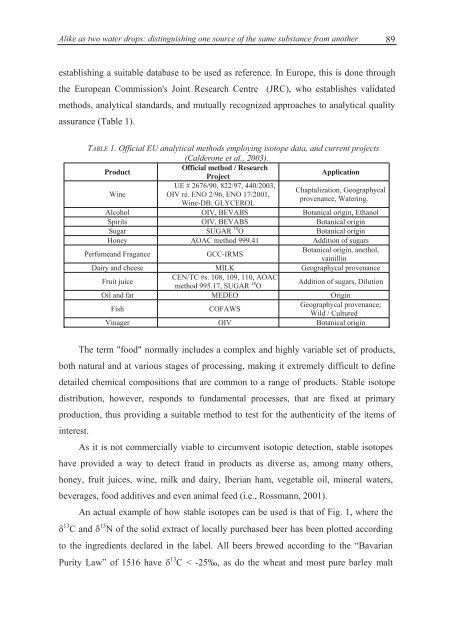instrumental techniques applied to mineralogy and geochemistry
instrumental techniques applied to mineralogy and geochemistry
instrumental techniques applied to mineralogy and geochemistry
Create successful ePaper yourself
Turn your PDF publications into a flip-book with our unique Google optimized e-Paper software.
Alike as two water drops: distinguishing one source of the same substance from another 89<br />
establishing a suitable database <strong>to</strong> be used as reference. In Europe, this is done through<br />
the European Commission's Joint Research Centre (JRC), who establishes validated<br />
methods, analytical st<strong>and</strong>ards, <strong>and</strong> mutually recognized approaches <strong>to</strong> analytical quality<br />
assurance (Table 1).<br />
TABLE 1. Official EU analytical methods employing iso<strong>to</strong>pe data, <strong>and</strong> current projects<br />
(Calderone et al., 2003).<br />
Product<br />
Official method / Research<br />
Project<br />
Application<br />
Wine<br />
UE # 2676/90, 822/97, 440/2003,<br />
Chaptalization, Geographycal<br />
OIV ré. ENO 2/96, ENO 17/2001,<br />
provenance, Watering.<br />
Wine-DB, GLYCEROL<br />
Alcohol OIV, BEVABS Botanical origin, Ethanol<br />
Spirits OIV, BEVABS Botanical origin<br />
Sugar SUGAR 18 O Botanical origin<br />
Honey AOAC method 999.41 Addition of sugars<br />
Perfume<strong>and</strong> Fragance<br />
GCC-IRMS<br />
Botanical origin, anethol,<br />
vainillin<br />
Dairy <strong>and</strong> cheese MILK Geographycal provenance<br />
Fruit juice<br />
CEN/TC #s. 108, 109, 110, AOAC<br />
method 995.17, SUGAR 18 O<br />
Addition of sugars, Dilution<br />
Oil <strong>and</strong> fat MEDEO Origin<br />
Fish<br />
COFAWS<br />
Geographycal provenance;<br />
Wild / Cultured<br />
Vinager OIV Botanical origin<br />
The term "food" normally includes a complex <strong>and</strong> highly variable set of products,<br />
both natural <strong>and</strong> at various stages of processing, making it extremely difficult <strong>to</strong> define<br />
detailed chemical compositions that are common <strong>to</strong> a range of products. Stable iso<strong>to</strong>pe<br />
distribution, however, responds <strong>to</strong> fundamental processes, that are fixed at primary<br />
production, thus providing a suitable method <strong>to</strong> test for the authenticity of the items of<br />
interest.<br />
As it is not commercially viable <strong>to</strong> circumvent iso<strong>to</strong>pic detection, stable iso<strong>to</strong>pes<br />
have provided a way <strong>to</strong> detect fraud in products as diverse as, among many others,<br />
honey, fruit juices, wine, milk <strong>and</strong> dairy, Iberian ham, vegetable oil, mineral waters,<br />
beverages, food additives <strong>and</strong> even animal feed (i.e., Rossmann, 2001).<br />
An actual example of how stable iso<strong>to</strong>pes can be used is that of Fig. 1, where the<br />
13 C <strong>and</strong> 15 N of the solid extract of locally purchased beer has been plotted according<br />
<strong>to</strong> the ingredients declared in the label. All beers brewed according <strong>to</strong> the “Bavarian<br />
Purity Law” of 1516 have 13 C < -25‰, as do the wheat <strong>and</strong> most pure barley malt













